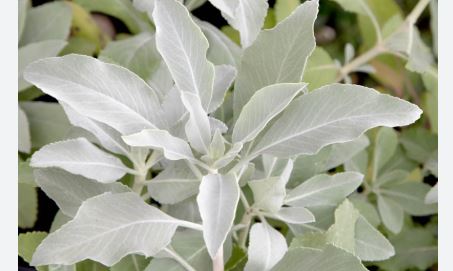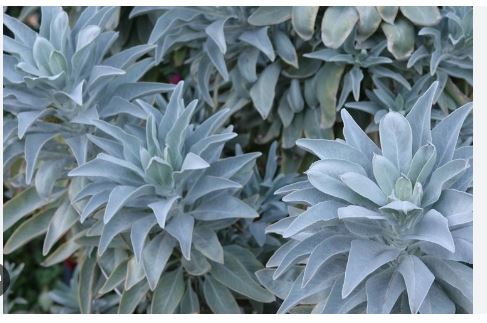
White Sage, scientifically known as Salvia apiana, belongs to the Lamiaceae family, a diverse group of aromatic herbs and shrubs that includes mint, lavender, and rosemary. The genus Salvia is one of the largest in the family, with over 900 species, ranging from culinary to ornamental plants. The species name “apiana,” derived from Latin, means “bee,” reflecting its attractiveness to pollinators. As a dicot, Salvia apiana is characterized by its square stems, opposite leaves, and tubular flowers, typical of the mint family. Its classification highlights its adaptation to arid environments, distinguishing it from more temperate Salvia species.
White Sage is an evergreen, perennial shrub growing 3–5 feet (0.9–1.5 meters) tall and 4–6 feet (1.2–1.8 meters) wide, with a mounding, open habit. Its leaves are thick, lance-shaped, and covered in fine, white-gray hairs, giving a silvery appearance; they measure 2–4 inches (5–10 cm) long and release a pungent, camphor-like aroma when crushed. The woody stems are grayish and brittle. From late spring to summer, it produces tall, arching flower spikes, 2–4 feet (60–120 cm) long, bearing clusters of small, white to pale lavender flowers, 0.5 inch (1.3 cm) long, with a two-lipped corolla. Seeds form in dry capsules, and the plant’s woolly texture and aromatic foliage make it unmistakable in its habitat.
Salvia apiana is native to the southwestern United States and northwestern Mexico, primarily found in southern California, Baja California, and parts of Arizona and Nevada. It thrives in coastal sage scrub, chaparral, and desert transition zones, below 5,000 feet (1,500 meters), favoring dry slopes, canyons, and alluvial plains with well-drained soils. As a key component of California’s native flora, it supports local pollinators like bees and butterflies. Due to its cultural and ornamental value, it is cultivated beyond its range in gardens across the U.S., Australia, and Mediterranean climates, though it remains most abundant in its native coastal and inland habitats.
White Sage is hardy in USDA zones 8a–11, tolerating temperatures as low as 15°F (-9°C) for brief periods, though prolonged cold may damage foliage or kill young plants. It thrives in warm, arid climates with temperatures between 50°F and 95°F (10°C–35°C), ideal for Mediterranean and desert regions. In zones 8a–8b, it benefits from winter protection, such as mulch or planting near south-facing walls. In colder zones (below 8a), it can be grown in containers and brought indoors during winter, adapting to indoor conditions with bright light and minimal watering.
White Sage has been used for centuries by Indigenous peoples, particularly in California, for its medicinal and spiritual properties. Its leaves, burned as smudge sticks, release smoke believed to cleanse spaces, objects, or individuals of negative energy, a practice rooted in Native American traditions. The plant’s essential oils contain compounds like cineole and camphor, which may have antimicrobial and anti-inflammatory effects, historically used in teas or poultices to treat colds, sore throats, or skin irritations. Inhaling its aroma may promote relaxation, though scientific studies are limited. Leaves were also chewed to freshen breath or relieve digestive issues. Modern herbalists caution against overuse, as internal consumption can be toxic in large amounts, and cultural sensitivity is urged when adopting traditional uses.
White Sage is a striking addition to xeriscapes, native gardens, and Mediterranean-style landscapes, valued for its silvery foliage, aromatic leaves, and drought tolerance. Its mounding form suits borders, rock gardens, or slopes, where it provides texture and contrasts with greener plants. Planted in groups, it creates a soft, naturalistic effect, attracting bees, butterflies, and hummingbirds, enhancing biodiversity. It thrives in low-water settings, ideal for urban gardens or near pathways, though its strong scent requires thoughtful placement. In containers, it adds a sculptural element to patios or courtyards. Its cultural significance makes it a meaningful choice for educational or heritage gardens, but sustainable sourcing is critical due to overharvesting concerns in the wild.

Cultivation of White Sage (Salvia apiana)
Cultivating White Sage (Salvia apiana) is rewarding for its aromatic foliage, pollinator-friendly flowers, and drought tolerance.
Light Requirements
Provide full sun, with at least 6–8 hours of direct sunlight daily, to promote robust growth and vibrant leaf color. White Sage thrives in open, sunny conditions typical of its native chaparral habitats. Partial shade reduces flowering and weakens its silvery appearance, so prioritize unshaded locations for optimal results.
Soil Preferences
Plant in well-draining, sandy, or gravelly soil with a pH of 6.0–7.5, mimicking its native rocky slopes. It tolerates poor, low-nutrient soils but benefits from minimal organic matter at planting. Avoid heavy clay or water-retentive soils, as they cause root rot; amend with sand or perlite if needed for drainage.
Watering Needs
Water sparingly, especially once established, providing about 1 inch (2.5 cm) every 2–3 weeks in summer, allowing soil to dry completely between waterings. During the first year, water weekly to establish roots. In winter, reduce or stop watering, as overwatering leads to fungal issues or root rot, a common problem in soggy conditions.
Temperature Range
Grow in USDA zones 8a–11, where temperatures range from 15°F to 95°F (-9°C to 35°C). It tolerates brief freezes but may lose leaves below 20°F (-6°C); protect with mulch in zones 8a–8b. In colder zones, cultivate in pots and move indoors during winter, keeping above 50°F (10°C) with bright light and minimal water.
Humidity Levels
White Sage prefers low humidity (20–40%), suited to arid and Mediterranean climates. High humidity increases risks of fungal diseases like powdery mildew, so ensure good air circulation around plants. Indoor specimens benefit from dry air; avoid misting or placing in humid areas to prevent leaf issues.
Container Selection
Choose pots with drainage holes to avoid water accumulation. Terracotta or clay pots are ideal, allowing soil to dry quickly, and should be 12–18 inches (30–45 cm) wide to support the shrub’s root system. Repot every 2–3 years to refresh soil, ensuring the container stabilizes its mounding growth.
Fertilization
Apply a low-nitrogen, slow-release fertilizer (e.g., 5-10-10 NPK) once in early spring to support growth without promoting excessive foliage. Alternatively, use a diluted liquid fertilizer monthly during spring–summer. Avoid over-fertilizing, as it weakens drought tolerance and reduces aromatic oils, diminishing the plant’s character.
Pruning
Prune lightly in late winter or early spring to shape the plant and remove dead or leggy stems, cutting just above a leaf node with clean shears. Avoid heavy pruning, as it stresses the plant and slows recovery. Harvest leaves sparingly for smudging or drying, taking no more than one-third of the plant to maintain vigor.
Propagation
Propagate via seeds or cuttings. Sow seeds in spring in a sandy mix at 70–75°F (21–24°C); germination takes 2–4 weeks. Softwood cuttings, taken in spring or early summer, root in 4–6 weeks with rooting hormone in well-draining soil. Keep cuttings moist but not soggy, and provide bright, indirect light until established.
Pest Control
Monitor for pests like aphids, whiteflies, or spider mites, which may target new growth. Inspect leaves regularly, treating infestations with insecticidal soap or neem oil in early morning to avoid leaf burn. Maintain proper watering and avoid overcrowding to enhance resilience, as stressed plants are more pest-prone.
Repotting
Repot container-grown White Sage every 2–3 years in spring, or when roots outgrow the pot. Gently remove the plant, trim any dead roots, and replant in fresh, well-draining mix at the same depth. Water lightly after repotting and provide shade for a week to minimize transplant shock, ensuring excellent drainage.
Winter Care
In zones 8a–8b, mulch the base with 2–3 inches (5–7.5 cm) of gravel or bark to insulate roots during cold snaps. Cover with frost cloth if freezes are forecast to protect foliage. Indoor plants require bright light, cool temperatures (50–60°F/10–16°C), and minimal watering during winter to mimic dormancy.
Common Issues
Address overwatering (yellowing leaves, root rot) by improving drainage and reducing frequency. Underwatering (wilting, dry leaves) needs slight watering increases. Poor flowering may indicate insufficient sun or excess fertilizer; adjust light or feeding. Powdery mildew from humidity can be prevented with better airflow and less overhead watering.